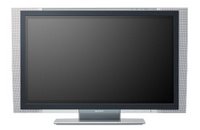Sony WEGA KDE-42XS955
 Its sound performance--from the pair of 25-watt integrated side speakers and the 50-watt removable rear-mounted subwoofer--was solid, with plenty of power, clean tones, and minimal distortion at high volume. Unfortunately, this TV's good quality traits end there.
Its sound performance--from the pair of 25-watt integrated side speakers and the 50-watt removable rear-mounted subwoofer--was solid, with plenty of power, clean tones, and minimal distortion at high volume. Unfortunately, this TV's good quality traits end there.Our judges especially noted its timid color and soft details. When calibrating the Sony, we chose its "Pro" image preset as the best match for our criteria. But muted color appeared to be a characteristic of that setting. So we also tried shifting to the "Standard" preset and pushing up the color level to better match the other TVs. But pushing the color much higher mainly served to reduce accuracy by introducing an orangey glow. (Like most of the eight TVs we reviewed, the KDE-42XS955 doesn't allow users to adjust individual red, green, and blue primary colors, so we couldn't fine-tune color biases.)
The silver-and-gray cabinet design is handsome. A card reader on the side of the panel allows you to view slide shows of digital pictures from your camera, assuming it uses Sony's Memory Stick flash media format. Unlike most other brands, Sony supports only its own format, not the more common CompactFlash and SD Card formats.
The TV allows you to save custom settings for each input and--huzzah!--you can save more than one for each input. This allows videophiles to calibrate for each source under various lighting conditions (such as daytime and nighttime). The KDE-42XS955 provides just three image modes (Pro, Standard, and Vivid), but they offer only starting points; you can change all of their parameters (such as color level and brightness), for up to three user-defined modes.
Upshot: Solid audio can't make up for this TV's poor color quality and detail rendering.
Source: pcworld





